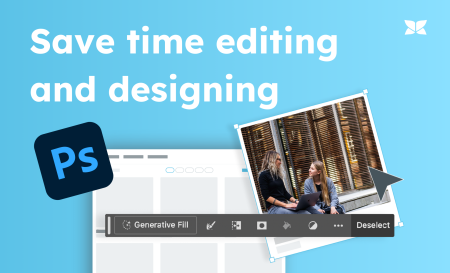Experience in a live demo how TESSA DAM efficiently manages your digital content.
What is a Brand Portal?
A Brand Portal is a digital platform where all essential information and resources of a brand are centralized and managed. BrandHub or Brand Portal are often used as alternative terms. This platform serves as a central point of contact for employees, partners, and agencies to ensure the brand is represented consistently and coherently. In a Brand Portal, you will typically find guidelines for logo usage, color palettes, fonts, image styles, communication tone, and other elements that define the brand identity. If your company produces many products, there may also be access to visual material related to these products, including text and other product data, depending on the scope.
To fully understand the concept of a Brand Portal, it's essential first to explain the term brand. A brand is more than just a logo or a name; it is the overall image that forms in consumers' minds when they think of a particular company, product, or service. This image encompasses emotional, visual, and linguistic associations built through consistent and thoughtful communication. A strong brand creates trust and recognition and differentiates itself from the competition. Product packaging also contributes to this recognition.
You also need to think about Corporate Identity (CI). CI is an integral part of a brand, encompassing all visual, linguistic, and behavioral characteristics that a company represents externally. In a Brand Portal, the focus is primarily on the visual components – Corporate Design (CD). CD includes the logo, company colors, fonts – CI also covers the communication style and the company's general values and principles. CI ensures that the company is perceived as a unit and creates a clear and unified brand identity.
A Brand Portal plays a crucial role in maintaining and conveying the Corporate Identity. It ensures that all parties use the same guidelines and resources to represent the brand uniformly. This is especially important in large organizations with many employees or companies working with external agencies and partners. A Brand Portal reduces the risk of inconsistencies and misrepresentations by providing a central access point to all relevant brand resources.
In addition to providing visual and linguistic guidelines, a Brand Portal often includes templates and tools that facilitate the creative process. For example, templates for presentations, social media posts, or promotional materials may be provided. These templates help keep the brand appearance consistent across various channels and media.
A well-structured Brand Portal thus significantly contributes to strengthening the brand and optimizing its perception among target audiences. It facilitates internal and external communication and ensures that all brand touchpoints convey a coherent and consistent image. Therefore, the Brand Portal makes an important contribution to sustainable brand management and the company's long-term success.
Why do brands need Brand Portals or Brandhubs?
Brands need Brand Portals, Brandhubs, or Brand Portals for several important reasons. These platforms play a crucial role in managing and maintaining the consistency of the brand identity. Here are the main reasons why such portals are indispensable:
- Consistency and Uniformity: Brand Portals ensure that all brand elements are used consistently. Whether it's logos, colors, fonts, or image styles – a Brand Portal centralizes these resources and makes them available to all relevant stakeholders. This prevents different interpretations of brand guidelines that could weaken brand perception.
- Efficiency and Time Savings: A Brand Portal saves you and your team valuable time. All necessary materials and guidelines are bundled in one place and easily accessible. This simplifies work and speeds up processes, as no time is wasted searching for the right files or information.
- Extensive Data Collection: Brand Portals allow you to provide much more data for self-service. Your partners can choose what they need themselves. Gathering the material internally would be too time-consuming. Particularly if your company produces and sells many products, appropriate software is extremely important for you.
- Protection of Brand Integrity: Using a Brand Portal ensures that the brand is used correctly and in accordance with defined standards. This protects the brand's integrity and minimizes the risk of misinterpretations or misapplications that could damage the brand image.
- Centralization of Knowledge: A Brand Portal serves as a knowledge database for all brand-related information. New employees can quickly get up to speed, and external partners or agencies have immediate access to all important documents and guidelines. This promotes unified communication and application of the brand.
- Flexibility and Adaptability: Brands must continuously evolve to stay relevant. A Brand Portal enables you to quickly and efficiently implement changes and updates, ensuring that all stakeholders are always up to date. This facilitates adaptation to new market conditions or strategic changes.
- Promotion of Creativity: Although a Brand Portal provides clear guidelines, it also offers room for creative development within the set framework. Templates and examples can inspire and serve as starting points for new ideas without compromising brand consistency.
- Improved Collaboration: In large companies or when working with external partners, a Brand Portal is a central tool that facilitates communication and collaboration. Especially if you have many product images, detail photos, mood, action, or application photos, it is important that all stakeholders have access to the same information and resources, reducing misunderstandings and increasing efficiency.
- Traceability and Control: A Brand Portal always gives you an overview of who is using which resources and how the brand is being applied. This enables better control and traceability, which is particularly important in regulated industries or sensitive projects.
Overall, Brand Portals, Brandhubs, or Brand Portals significantly contribute to optimizing brand management and positioning the brand successfully in the long term. They are indispensable tools to meet the complex demands of modern brand management and ensure that the brand remains consistent and strong across all communication channels and touchpoints.
What are the components of software solutions for brand portals?
Software solutions for Brand Portals, Brandhubs, or Brand Portals consist of several essential components that help you manage your brand resources efficiently and ensure the consistency of your brand communication. Ultimately, these generally come from two areas – they are either specialized content management systems (CMS) or digital asset management systems (DAM). Here are the key components of such software solutions:
- Digital Asset Management (DAM): Especially for solutions for companies with many products, DAM is the core of a Brand Portal solution. A DAM system allows you to store, organize, and manage all digital assets such as logos, images, videos, documents, and other media in one central location. DAM systems offer features like tagging, categorization, and advanced search capabilities to facilitate the findability and management of assets. TESSA DAM is one such core component.
- Brand Guidelines and Style Guides: A Brand Portal typically includes detailed brand guidelines and style guides. These documents define the visual and linguistic standards of your brand, including the use of logos, colors, fonts, image styles, and tone. These guidelines help you ensure that all stakeholders consistently represent the brand. These are documents that define the brand.
- Templates and Layouts: These are files that you store for others to use to create materials – templates and layouts for various marketing materials such as presentations, social media posts, flyers, posters, and more. These templates are adapted to the brand guidelines and allow you and your team to quickly and easily create consistent marketing materials.
- Collaboration: Another important component is support for team collaboration and management in terms of collaboration. This ensures that all stakeholders work together effectively and the approval process for marketing materials runs smoothly.
- Rights Management and Access Control: Brand Portal solutions typically offer extensive functions for managing user rights and access control. You can define who has access to which content and what actions can be performed. This is particularly important to ensure that confidential or sensitive brand resources are protected and only authorized persons can access them.
- Integration with Other Systems: Brand Portals often offer integrations with other marketing and content management systems. This enables seamless collaboration between different tools and platforms and facilitates the exchange and synchronization of content. For example, Brand Portals can be integrated with CMS, CRM, social media management tools, and email marketing platforms.
By combining these components, Brand Portals offer a comprehensive solution for managing and ensuring the consistency of your brand resources. They help you increase efficiency, improve collaboration, and protect the integrity of your brand, enabling you to successfully implement your brand strategy.
Which BrandHub, Brand Portal, or Brand Portal suits me?
Choosing the right BrandHub, Brand Portal, or Brand Portal depends on various factors that consider your specific needs and requirements. Here are some criteria that can help you make the right decision:
- Company Size and Structure: Consider how large your company is and how complex its structure is. Large companies with multiple departments and international teams may require a more comprehensive solution with advanced features and collaboration capabilities. If your company is both a producer and distributor, the requirements are usually so complex that you will need an enterprise DAM solution. The Brand Portal, or BrandHub, will be the frontend to it.
- Number of Products: The more different products your company sells, the more important a DAM system with enterprise functionalities becomes for you.
- Scope of Functions: Create a list of the functions you need. These might include Digital Asset Management (DAM), template management, workflow management, analytics and reporting tools, user and rights management, as well as integrations with other systems. Ensure the solution you consider offers all essential features.
- User-Friendliness: The user-friendliness of the frontend is important to ensure that your team can use the platform effectively. Make sure the solution has an intuitive user interface and is easy to navigate.
- Integration Capabilities: Consider what other systems and tools you use in your company. A Brand Portal should seamlessly integrate into your existing IT landscape. Check if the solution can integrate with your Content Management System (CMS), Customer Relationship Management System (CRM), Digital Asset Management (DAM), social media management tools, and other relevant platforms.
- Support and Training Resources: Good support and comprehensive training resources are essential to ensure that you and your team can utilize the platform optimally. Make sure the provider offers training, user manuals, and reliable customer support.
- Costs: Consider your budget. The costs for Brand Portals can vary greatly depending on the scope of functions and company size. Determine which solution offers the best value for money and check if there are flexible pricing models that meet your needs.
What is better – stand-alone Brand Portal or part of a DAM?
It depends on your specific situation. If your company produces and distributes many products, a powerful DAM is required for process management – something like our TESSA DAM. With it, you can use your assets across various tools and solutions – whether they need to go on your website, marketplaces, product data sheets, catalogs, or your CRM tool. That’s why we developed the TESSA BrandHub, a Brand Portal that is also suitable for self-service.
If you have fewer products and a lot of material, a Brand Portal that uses a CMS as a background may be appropriate. But even in this case, you can use our TESSA BrandHub standalone. The TESSA DAM is not required as a base. You can directly import assets and product data or use a Product Information Management System (PIM) as the basis.
Should product images be included in the Brand Portal, BrandHub?
Yes, of course, product images should be included in your BrandHub. Products communicate your brand. Therefore, photos, images, and drawings belong in a Brand Portal. This is true even for brands with few products, where there are usually many photos per product. The more products a brand has, the fewer photos there are typically per individual product. However, the number of assets increases overall. Therefore, brands with many products usually need a full-fledged Digital Asset Management system as the base and a BrandHub as the self-service application for asset distribution. This also applies to companies with many brands.
Examples of brand portals
We all know brands like Nike, Coca-Cola, Adobe, Bosch and Apple. Each of these brands has an impressive brand portal where they showcase their brand identity and interact with their customers. However, there are other examples such as LAMY or ZEG, which present their brand excellently with TESSA BrandHub.
Which target groups use BrandHubs, Brand Portals, or Brand Portals?
BrandHubs, Brand Portals, or Brand Portals cater to various target groups, all aiming for the efficient management and consistency of brand identity. Here are the main target groups that benefit greatly from such platforms:
- Marketing Teams: Marketing teams within larger companies are a primary target group for Brand Portals. They use these platforms to centrally manage all marketing materials, ensure campaign consistency, and comply with brand guidelines. Easy access to templates and assets allows marketing teams to work more efficiently and respond quickly to market changes.
- Design and Creative Teams: Design and creative teams benefit from Brand Portals by finding all the resources they need in one place. They can access up-to-date logos, color palettes, fonts, and other design elements to ensure their work meets brand standards. This fosters creative efficiency and ensures a unified visual communication.
- Sales Teams: Sales teams use Brand Portals to access current sales materials, presentations, and other resources needed to share with customers and partners. Centralized access to consistent and brand-compliant materials enhances sales team efficiency and helps present a unified brand image.
- External Agencies and Partners: External agencies and partners involved in creating marketing campaigns, advertising, or other brand-related projects also benefit from Brand Portals. They get access to the latest brand guidelines and resources, facilitating collaboration and ensuring that all external communication is brand-compliant. This applies to sales partners as well.
- Press: Journalists are also external partners, albeit special ones. They need a similar spectrum of materials, often with a more specific selection of assets. Nevertheless, a Digital Asset Management System (DAM) serves as a suitable source.
- Company Leadership and Brand Managers: Company leadership and brand managers use Brand Portals to monitor compliance with brand guidelines and manage brand strategy. They can use analytics and reports to assess the effectiveness of brand communication and make informed decisions for brand development.
- HR Departments: HR departments use Brand Portals to ensure that all internal and external communication materials, including job postings, training materials, and onboarding documents, are brand-compliant. This supports a consistent employer brand and contributes to a positive perception of the company.
- Product Management Teams: Product management teams use Brand Portals to ensure that product packaging, user manuals, and other product-related materials adhere to brand guidelines. This ensures a uniform product presentation and strengthens the brand in the market.
- Customer Service Teams: Customer service teams benefit from Brand Portals by having access to brand-compliant response templates, FAQ documents, and other resources. This allows them to provide consistent and brand-compliant responses to customer inquiries, strengthening the brand image.
By providing centralized access to all brand-relevant resources and guidelines, Brand Portals support a variety of target groups within and outside a company. This promotes consistency and efficiency in brand communication and ensures that all stakeholders present the brand uniformly and professionally.
Conclusion
Consistency and uniformity with BrandHub
You need a BrandHub whenever you want to maintain your brand with visual materials and have several target groups. It ensures consistency and uniformity in your communication, both internally and externally. You work significantly more efficiently than with general CMS systems. Centralization enables more creativity and improved collaboration. If you also have many products, it is helpful for a Brand Portal to be supplied with data from a full-fledged enterprise-class DAM, such as the TESSA DAM. This way, you can map many processes even more efficiently. The TESSA BrandHub is then the frontend, which can also be used standalone in simpler cases.









